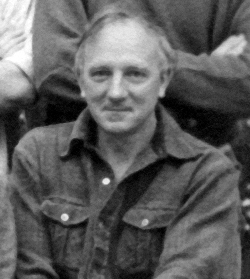
Frank was the archetypal 20th Century field geologist. His great love was the outdoors and he always said he didn’t regard teaching geology, or finding out what rocks in the field meant, as work at all.
Born in Bradford in 1922, he volunteered as a pilot in the RAF during World War II. He flew Blenheim bombers in Africa and the Middle East where the cockpit panoramas inspired in him the desire to find out how rocks came to form such wonderful and awe-inspiring features as Nanga Parbat and Kilimanjaro. He climbed the latter during leave in 1942, long before it was a routine tourist adventure. So, in 1946 he studied geology at Sheffield University, where he started a life-long association with his Professor, Fred Shotton. He obtained a First Class Honours degree (with the Sorby Prize for mapping) and a PhD (Namurian of the Bowland Fells). He then spent six years at Keele and Cambridge universities before moving to Birmingham under Fred Shotton from 1958-89, becoming Reader in Geology.
Frank’s most enduring scientific contribution will undoubtedly be to Lake District geology. He researched the lithostratigraphy and structural evolution, supervising many PhD students. He was the first post-war geologist to make any sense of the Borrowdale Volcanic rocks. He was a pioneer in the interpretation of aerial photographs in geology, and his meticulous mapping and careful detailed study of these rocks opened up the way to our modern understanding of this Ordovician volcanic complex. For nearly 30 years he inspired Birmingham students in field mapping classes at Coniston and Keswick, showing how aerial photographic detail could be combined with field data into an accurate knowledge of the geology. As well as original scientific papers and synoptic reviews, he also published field guides to the Lake District and Southern Spain. His book
Methods in Field Geology (1981) is a testament to his field craft and is typically illustrated by his technique of diagrams produced by photocopying photographs with judicious enhancement to clarify and explain the geology.
The influence of Fred Shotton is also seen in Frank’s other research interests: Quaternary deposits of the Midlands, hydrogeology and engineering geology. The last two were his principal interests as a Major in the Geology Pool of the Royal Engineers from 1953-70; he was awarded their Montgomerie Prize in 1967. He worked in East Africa, Libya, Cyprus, South Yemen and Oman, these assignments often leading to major publications, e.g. the first geological map of Socotra.
In his youth he was a notable athlete, being a 440 yards, high jump and pole vault champion and he continued to vault and play rugby into his 40s. Frank was awarded the Murchison Fund of this Society in 1973, the Charles Edmonds Memorial Prize of the Cumberland G.S. in 1979 and the Sorby Medal of the Yorkshire G.S. in 1987. In his retirement he continued to explore the world in the company of Pat, his wife for 56 years, his two daughters, son and grandchildren.
Alan Wright, with David Millward